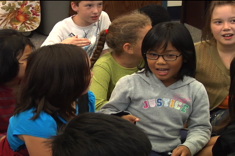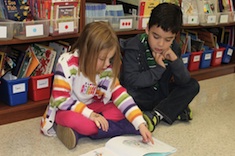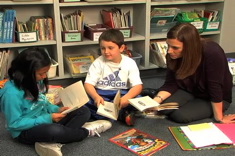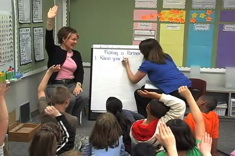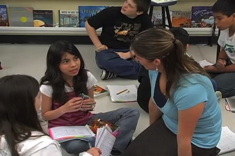“Hey! Watch where you’re going!” shouted a well-groomed, confident-looking boy. “Sorry,” muttered his assailant. The third graders were entering the classroom to read with their first-grade reading buddies. The “assailant” was a disheveled boy. He was one of the shortest students in the class. His clothes were rumpled, and he needed a haircut. He bumped into his classmate because he was deeply engrossed in the book that he had selected to read to his buddy. He hadn’t noticed that the line had momentarily paused.
Laura, the literacy coach, invited me to see the Reading Buddies project that she had instituted in her school. I watched the disheveled boy as he made his way across the room to his buddy. The first grader was standing, waving, and shouting, “Chad! Chad! I’m over here! I got us the beanbag chair.” The two boys settled into the beanbag chair and immediately became lost in the book. The Reading Buddies project seemed to be going well. As I looked around the room, I saw pairs of children reading and talking about books. My eyes kept going back to Chad and his buddy. Every time I looked at them, they were poring over a page together. Sometimes Chad was reading, and at other times the first grader was reading. They were completely oblivious to the buzz of activity around them.
As the third graders left the room, I pointed out Chad to Laura. I said, “Tell me about Chad.” She rolled her eyes and sighed. She asked, “Was he causing trouble again? I didn’t see him.” I said, “Does he usually cause trouble during Reading Buddies?” She replied, “I don’t specifically remember him being a problem during Reading Buddies, but he is a problem.”
Chad’s story was a familiar story of an urban child who was not experiencing success in school. He lived in a single parent home with three brothers and sisters. Chad seldom brought supplies, handed in homework, completed classroom assignments, or returned the forms that were sent home. The notable exception was the application for free lunch — that was always returned. His mother did not respond to the school’s multiple requests that she come in for a conference.
The teacher’s biggest concern was Chad’s flat-out refusal to read. During independent reading time, he sat with a book opened, but he was clearly not reading it. His literature response journal was filled with doodles that were unrelated to any books. During literature circles, he would sullenly report, “I didn’t read the chapter.” Then he would just sit while the other children discussed the book. Chad’s teacher said that he didn’t respond to punishment or incentives.
I suggested that maybe Chad had found his niche. I reported that he seemed to be very involved during Reading Buddies. He had made a real connection with his first-grade buddy and he was definitely reading. Laura said that she would be sure to observe him carefully during the next session of Reading Buddies.
Observing Chad
I got a call from Laura the next week. She said, “You were right. Chad was reading.” I asked, “So what happens now?” She replied, “I’m going to invite him to my office to pick a book for Reading Buddies.” The next day, Laura went down to the lunchroom during breakfast and asked Chad if he’d like to come to her office a pick a book for Reading Buddies. Chad readily agreed.
Chad spent a long time flipping through the book baskets. Laura noticed that sometimes he would take out a book, open it, glance at it, and quickly put it back in the basket. At other times, he would closely examine a book for a long time, muttering under his breath. It was during one of those times that Laura spoke up. She said, “What do think of that book?” Chad said, “Well…I like it, but it’s a little hard.” Laura said, “Would you like me to help you?” Chad agreed, and that was the beginning.
By reading through parts of several books, Laura estimated that Chad was reading at about a mid-first grade level. She looked at the test data that his teacher provided. Chad was described as a child in need of “intensive” support by the DIBELS. Unfortunately, the assessment did not give any information on his current reading level. Chad’s teacher reported that Chad was incredibly uncooperative during informal assessments. The books that were being used for literature circles in Chad’s class were completely beyond his abilities. Chad reported that there were some books in his classroom library that he could read. He said that he always picked one of those books for Reading Buddies. Laura asked, “Why don’t you pick one of those books to read during independent reading time?” Chad mumbled, “I can’t.” Laura pressed him and asked, “Why not?” After a long pause, Chad confessed, “Because they are baby books.”
Laura arranged for Chad to work with one of the literacy volunteers who regularly came to the school. Chad was told that the volunteer was going to help him get ready for next week’s session of Reading Buddies. Chad and the volunteer worked together three times a week for a period of 20-30 minutes after breakfast and before the start of the school day. They read through three to five books a week. Chad would select one of the books to read to his buddy. Chad and the volunteer worked together for 15 weeks.
Chad significantly increased the amount of reading that he was doing. He was checking out books to read at home. Chad’s teacher sought out opportunities for including easier texts in her lessons. Chad began making progress as a reader. He still had a way to go to get to grade level, but now he was reading.
Laura reported at a coaching network meeting that she was well-versed in the advantages of Reading Buddies for the “little buddy.” Specifically, the Reading Buddies program:
- gives children an authentic reason for rereading text to build fluency. Those repeated readings help to increase the children’s sight word vocabulary.
- engages children in reading for enjoyment.
- provides children with an audience for their developing reading skills.
- provides children with a model of fluent reading.
- provides children with a “reading role model.”
- increases the amount of reading that children are doing.
However, she was embarrassed to confess that she had never given much thought to the advantages of Reading Buddies for the “big buddy” in terms of literacy development. She knew that it was an opportunity for the older children to provide a service to the school and to learn about citizenship and responsibility. It’s like when the older brothers and sisters in a family read aloud to the little brothers and sisters.
Laura vowed that in the future, she would seek out the Chads in her school when initiating the Reading Buddies program. Reading Buddies can provide a legitimate reason for the big buddies to read “baby books.” Under the guise of preparation for the next Reading Buddies session, these students will have the opportunity to spend time reading independent level texts. It might be just what they need to get them back on the road to making progress in reading.

